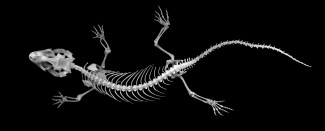
Johns Hopkins UniversityEst. 1876
America’s First Research University
I Think of You When I See Roadkill

If I had a nickel for every time I’ve heard that from one of my students, I’d be a rich man. Most people hearing that would be downright offended, and understandably so. To 99 out of 100 people it would be an insult. To me, however, it’s like music to my ears. It means a student got the full experience in my “Animal Form and Function” course where they were forced to dissect a carcass, feed it to flesh-eating beetles, and rebuild the remains. Some do it well. They get A’s. Others produce monstrosities of unknown origin with hints of mythical creatures. They don’t get A’s. But both populations still tell me they think of me when they see roadkill.
I wrote The Skeleton Revealed for a couple reasons. First, I’ve been fascinated by bones, especially dinosaur bones, since I was a kid. And, like most little boys with dinosaur toys around their bedroom, bringing them back to life and guessing how they’d act consumed hours of my life. How many times have you seen a young child pick-up a dinosaur toy and say, “RARRR!”? Unfortunately, while we think we know how dinosaurs communicated, we’ll never truly know because they’re extinct; we can’t watch them in action anymore.

My career has taken me down a similar path, only with living species. The beauty of this is I can watch them in action. How do they do the amazing things that fascinate us as viewers? What makes a constrictor, with no arms or legs, so capable of squeezing the life out of prey? How can a fish, living in something 800 times denser than air, swim at speeds faster than a cheetah can run? How can a 2-pound piranha generate more pound-for-pound bite force than a 2000-pound great white shark? Only through an understanding of the skeletal system can we, as experts, make predictions about an animal’s full potential. And we see their full potential when we watch their behaviors – only possible by moving the skeleton.
With this in mind, I also wrote this book to help everyday enthusiasts better understand what makes the world of wildlife so fascinating. The diversity of shapes, sizes, mechanisms, and behaviors hinges on the bones hidden beneath. Only by tearing an animal apart can we truly understand what keeps it all together. Hopefully, my book helps you better understand and appreciate the complexity of all that lies beneath the skin of an animal. And, just maybe, you’ll think of me the next time you see roadkill.
Steve Huskey is an associate professor of biology at Western Kentucky University. Dr. Huskey’s skeletons are on display in many venues, including the Harvard Museum of Natural History, the California Academy of Sciences, and the Miami Museum of Science and Planetarium. His latest book, The Skeleton Revealed: An Illustrated Tour of the Vertebrates is available now.


